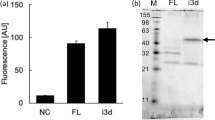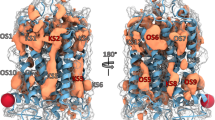Abstract
G protein–coupled receptors (GPCRs) comprise one of the largest protein families found in nature. Here we describe a new experimental strategy that allows rapid identification of functionally critical amino acids in the rat M3 muscarinic acetylcholine receptor (M3R), a prototypic class I GPCR. This approach involves low-frequency random mutagenesis of the entire M3R coding sequence, followed by the application of a new yeast genetic screen that allows the recovery of inactivating M3R single point mutations. The vast majority of recovered mutant M3Rs also showed substantial functional impairments in transfected mammalian (COS-7) cells. A subset of mutant receptors, however, behaved differently in yeast and mammalian cells, probably because of the specific features of the yeast expression system used. The screening strategy described here should be applicable to all GPCRs that can be expressed functionally in yeast.
This is a preview of subscription content, access via your institution
Access options
Subscribe to this journal
Receive 12 print issues and online access
$259.00 per year
only $21.58 per issue
Buy this article
- Purchase on Springer Link
- Instant access to full article PDF
Prices may be subject to local taxes which are calculated during checkout




Similar content being viewed by others
References
Pierce, K.L., Premont, R.T. & Lefkowitz, R.J. Seven-transmembrane receptors. Nat. Rev. Mol. Cell Biol. 3, 639–650 (2002).
Kristiansen, K. Molecular mechanisms of ligand binding, signaling, and regulation within the superfamily of G-protein-coupled receptors: molecular modeling and mutagenesis approaches to receptor structure and function. Pharmacol. Ther. 103, 21–80 (2004).
Foord, S.M. et al. International Union of Pharmacology. XLVI. G protein-coupled receptor list. Pharmacol. Rev. 57, 279–288 (2005).
Wess, J. Molecular biology of muscarinic acetylcholine receptors. Crit. Rev. Neurobiol. 10, 69–99 (1996).
Wess, J. Molecular basis of receptor/G-protein-coupling selectivity. Pharmacol. Ther. 80, 231–264 (1998).
Pausch, M.H. G-protein-coupled receptors in Saccharomyces cerevisiae: high-throughput screening assays for drug discovery. Trends Biotechnol. 15, 487–494 (1997).
Dowell, S.J. & Brown, A.J. Yeast assays for G-protein-coupled receptors. Recept. Chann. 8, 343–352 (2002).
Beukers, M.W. & Ijzerman, A.P. Techniques: how to boost GPCR mutagenesis studies using yeast. Trends Pharmacol. Sci. 26, 533–539 (2005).
Stefan, C.J. & Blumer, K.J. The third cytoplasmic loop of a yeast G-protein-coupled receptor controls pathway activation, ligand discrimination, and receptor internalization. Mol. Cell. Biol. 14, 3339–3349 (1994).
Konopka, J.B., Margarit, S.M. & Dube, P. Mutation of Pro-258 in transmembrane domain 6 constitutively activates the G protein-coupled α-factor receptor. Proc. Natl. Acad. Sci. USA 93, 6764–6769 (1996).
Sommers, C.M. & Dumont, M.E. Genetic interactions among the transmembrane segments of the G protein coupled receptor encoded by the yeast STE2 gene. J. Mol. Biol. 266, 559–575 (1997).
Baranski, T.J. et al. C5a receptor activation. Genetic identification of critical residues in four transmembrane helices. J. Biol. Chem. 274, 15757–15765 (1999).
Erlenbach, I. et al. Single amino acid substitutions and deletions that alter the G protein coupling properties of the V2 vasopressin receptor identified in yeast by receptor random mutagenesis. J. Biol. Chem. 276, 29382–29392 (2001).
Schmidt, C. et al. Random mutagenesis of the M3 muscarinic acetylcholine receptor expressed in yeast. Identification of point mutations that “silence” a constitutively active mutant M3 receptor and greatly impair receptor/G protein coupling. J. Biol. Chem. 278, 30248–30260 (2003).
Li, B. et al. Random mutagenesis of the M3 muscarinic acetylcholine receptor expressed in yeast: identification of second-site mutations that restore function to a coupling-deficient mutant M3 receptor. J. Biol. Chem. 280, 5664–5675 (2005).
Erlenbach, I. et al. Functional expression of M1, M3 and M5 muscarinic acetylcholine receptors in yeast. J. Neurochem. 77, 1327–1337 (2001).
Schöneberg, T., Liu, J. & Wess, J. Plasma membrane localization and functional rescue of truncated forms of a G protein-coupled receptor. J. Biol. Chem. 270, 18000–18006 (1995).
Zeng, F.-Y., Soldner, A., Schöneberg, T. & Wess, J. Conserved extracellular cysteine pair in the M3 muscarinic acetylcholine receptor is essential for proper receptor cell surface localization but not for G protein coupling. J. Neurochem. 72, 2404–2414 (1999).
Dohlman, H.G., Thorner, J., Caron, M.G. & Lefkowitz, R.J. Model systems for the study of seven-transmembrane-segment receptors. Annu. Rev. Biochem. 60, 653–688 (1991).
Hampsey, M. A review of phenotypes in Saccharomyces cerevisiae. Yeast 13, 1099–1133 (1997).
Cadwell, R.C. & Joyce, G.F. Mutagenic PCR. PCR Methods Appl. 3, S136–S140 (1994).
Oldenburg, K.R., Vo, K.T., Michaelis, S. & Paddon, C. Recombination-mediated PCR-directed plasmid construction in vivo in yeast. Nucleic Acids Res. 25, 451–452 (1997).
Lu, Z.L., Saldanha, J.W. & Hulme, E.C. Seven-transmembrane receptors: crystals clarify. Trends Pharmacol. Sci. 23, 140–146 (2002).
Hulme, E.C., Lu, Z.L. & Bee, M.S. Scanning mutagenesis studies of the M1 muscarinic acetylcholine receptor. Recept. Chann. 9, 215–228 (2003).
Ballesteros, J.A. & Weinstein, H. Integrated methods for modeling G-protein coupled receptors. Meth. Neurosci. 25, 366–428 (1995).
Palczewski, K. et al. Crystal structure of rhodopsin: A G protein–coupled receptor. Science 289, 739–745 (2000).
Han, S.J. et al. Pronounced conformational changes following agonist activation of the M3 muscarinic acetylcholine receptor. J. Biol. Chem. 280, 24870–24879 (2005).
Behrendt, H.J., Germann, T., Gillen, C., Hatt, H. & Jostock, R. Characterization of the mouse cold-menthol receptor TRPM8 and vanilloid receptor type-1 VR1 using a fluorometric imaging plate reader (FLIPR) assay. Br. J. Pharmacol. 141, 737–745 (2004).
Cheng, Y. & Prusoff, W.H. Relationship between the inhibition constant (Ki) and the concentration of inhibitor which causes 50 per cent inhibition (I50) of an enzymatic reaction. Biochem. Pharmacol. 22, 3099–3108 (1973).
Acknowledgements
This article is dedicated to the memory of Bo Li who died on October 20, 2006, in a tragic traffic accident. This research was supported by the Intramural Research Program of the National Institutes of Health (NIH), National Institute of Diabetes and Digestive and Kidney Disorders (NIDDK). We thank Dr. P. William (NIH-NIDDK) for his help with the microscopic studies.
Author information
Authors and Affiliations
Corresponding author
Ethics declarations
Competing interests
The authors declare no competing financial interests.
Supplementary information
Supplementary Table 1
A C-terminal EGFP tag has no significant effect on the ligand binding and functional properties of the full-length rat M3R transiently expressed in COS-7 cells.
Supplementary Table 2
Use of error-prone PCR to generate yeast libraries expressing randomly mutagenized mutant M3Rs.
Supplementary Table 3
Complexity of the yeast libraries expressing randomly mutagenized mutant M3Rs generated via error-prone PCR.
Supplementary Table 4
Characterization of mutant M3Rs recovered in the yeast genetic screen in transfected COS-7 cells.
Supplementary Note 1
Functional activity in yeast of mutant M3Rs containing amino acid substitutions at position Leu225.
Supplementary Note 2
Mutant M3Rs displaying reduced Bmax values and cell surface expression.
Supplementary Note 3
Predicted location and interactions of functionally important TM I and II residues in the 3D structure of the M3R.
Rights and permissions
About this article
Cite this article
Li, B., Scarselli, M., Knudsen, C. et al. Rapid identification of functionally critical amino acids in a G protein–coupled receptor. Nat Methods 4, 169–174 (2007). https://doi.org/10.1038/nmeth990
Received:
Accepted:
Published:
Issue Date:
DOI: https://doi.org/10.1038/nmeth990
This article is cited by
-
Recovery of the histamine H3 receptor activity lost in yeast cells through error-prone PCR and in vivo selection
Scientific Reports (2023)
-
Improving the functionality of surface-engineered yeast cells by altering the cell wall morphology of the host strain
Applied Microbiology and Biotechnology (2021)
-
Activation and allosteric modulation of a muscarinic acetylcholine receptor
Nature (2013)
-
Membrane-displayed somatostatin activates somatostatin receptor subtype-2 heterologously produced in Saccharomyces cerevisiae
AMB Express (2012)
-
Structure and dynamics of the M3 muscarinic acetylcholine receptor
Nature (2012)



